 |
 |
 |
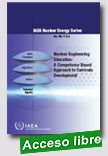 |
Nuclear Engineering Education: A Competence Based Approach to Curricula Development
IAEA Nuclear Energy Series, 2014, 39 p.
Maintaining nuclear competencies in the nuclear industry is a one of the most critical challenges in the near future. With the development of a number of nuclear engineering educational programmes in several States, this publication provides guidance to decision makers in Member States on a competence based approach to curricula development, presenting the established practices and associated |
requirements for educational programmes in this field. It is a consolidation of best practices that will ensure sustainable, effective nuclear engineering programmes, contributing to the safe, efficient and economic operation of nuclear power plants. The information presented is drawn from a variety of recognized nuclear engineering programmes around the world and contributes to the main areas that are needed to ensure a viable and robust nuclear industry.
Extraído de: http://www-pub.iaea.org/books/IAEABooks/10432/Nuclear-Engineering-Education-A-Competence-Based-Approach-to-Curricula-Development
|
 |
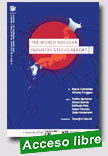 |
World Nuclear Industry Status Report 2014
Mycle Schneider Consulting, July 2014, 2014, 159 p.
The World Nuclear Industry Status Report 2014 provides a comprehensive overview of nuclear power plant data, including information on operation, production and construction. The WNISR assesses the status of new-build programs in current nuclear countries as well as in potential newcomer countries. A 20-page chapter on nuclear economics looks at the rapidly changing market conditions for nuclear power plants, whether operating, under construction, or in the planning stage.
|
Reactor vendor strategies and the “Hinkley Point C Deal” are analyzed in particular. The performance on financial markets of major utilities is documented.
The WNISR2013 featured for the first time a Fukushima Status Report that triggered widespread media and analyst attention. The 2014 edition entirely updates that Fukushima chapter.
WNISR2014 - browse online
Extraído de: http://www.worldnuclearreport.org/IMG/pdf/201408msc-worldnuclearreport2014-hr-v4.pdf |
 |
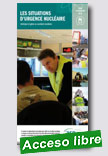 |
Les Situations d'Urgence Nucléaire (Fiche d'information du public n°6)
L’Autorité de Sûreté Nucléaire, 24/07/2014, 4 p.
Si toutes les dispositions sont prises pour éviter un accident nucléaire, ce risque ne doit pas être écarté. Pour être efficacement géré, il doit être anticipé. La population, les exploitants nucléaires et les pouvoirs publics doivent être prêts à y faire face. |
Extraído de: http://www.asn.fr/Informer/Publications/Fiches-d-information-du-public/Les-situations-d-urgence-nucleaire
|
 |
 |
Reference Data Series No. 1 (RDS-1) is an annual publication — currently in its thirty-fourth edition — containing estimates of energy, electricity and nuclear power trends up to the year 2050.
RDS-1 starts with a summary of the situation of nuclear power in IAEA Member States as of the end of 2013. The data on nuclear power presented in Tables 1 and 2 are based on actual statistical data collected by the IAEA’s Power Reactor . |
Information System (PRIS). However, energy and electricity data for 2013 are estimated, as the latest information available from the United Nations Department of Economic and Social Affairs is for 2011.
Population data originate from the World Population Prospects (2010 revision), published by the Population Division of the United Nations Department of Economic and Social Affairs. The 2013 values again are estimates.
As in previous editions, projections of future energy and electricity demand and the role of nuclear power are presented as low and high estimates encompassing the inherent uncertainties involved in projecting trends. The RDS-1 estimates should be viewed as very general growth trends whose validity must be constantly subjected to critical review
Extraído de:
http://www-pub.iaea.org/MTCD/Publications/PDF/EPR-Medical_T_2011/PDF/Introduction.pdf
|
 |
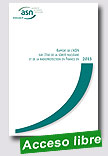 |
Rapport de l´ASN sur l’état de la sûreté nucléaire et de la radioprotection en France en 2013
L’Autorité de Sûreté Nucléaire, 2014, 538 p.
En 2013, l’ASN a poursuivi activement ses actions de contrôle de la sûreté nucléaire et de la radioprotection. L’année 2013 se situe globalement dans la continuité des années précédentes et l’ASN n’a pas constaté de nouveau problème majeur. Le nombre des incidents déclarés est resté stable. De ce point de vue, la situation actuelle est globalement assez satisfaisante.
|
Ce constat ne doit pas faire oublier que des événements aux conséquences de grandes ampleurs, comme ceux de Fukushima et d’Épinal, peuvent se produire. La persistance d’incidents significatifs appelle à maintenir la vigilance vis-à-vis du risque d’un accident grave toujours possible.
Mais surtout ce constat ne doit pas masquer l’importance des prochaines échéances pour la sûreté nucléaire et la radioprotection. Des décisions lourdes devront en effet être prises dans un proche avenir sur la poursuite du fonctionnement des réacteurs électronucléaires, la gestion d’un accident nucléaire en Europe, le projet de stockage des déchets radioactifs en couche géologique profonde, la maîtrise des expositions médicales aux rayonnements ionisants ou l’exposition au radon.
Extraído de http://www.asn.fr/Informer/Publications/Rapports-de-l-ASN/La-surete-nucleaire-et-la-radioprotection-en-France-en-2013 |
 |
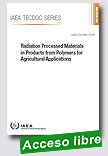
|
Radiation Processed Materials in Products from Polymers for Agricultural Applications
IAEA TECDOC, 2014, 222 p.
One of the major objectives of the 20 country participants who took part in this Technical Meeting on Radiation Processed Materials in Products from Polymers for Agricultural Applications was to review the recent developments as well as revisit global, regional, and national level initiatives for the use of radiation technologies in the preparation of green products based on polymers for agricultural applications.
|
Focus was given to presenting new concepts and the practical utilization of radiation
techniques with the end result of evolving a strategy for the deployment of these technologies.
The need for further scientific and technological development in this area has also been recognized. The meeting provided a forum for the sharing of practical experiences and lessons learned in the use of radiation technologies in the preparation of products for various agricultural uses. It also served to strengthen contacts and encourage cooperation between technology providers and end-users
Extraído de: http://www-pub.iaea.org/MTCD/Publications/PDF/TE-1745_web.pdf
|
 |
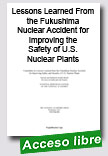 |
Lessons Learned From the Fukushima Nuclear Accident for Improving the Safety of U.S. Nuclear Plants
National Academy of Sciences (US), 24 July, 2014, 366 p.
The March 11, 2011, Great East Japan Earthquake and tsunami sparked a humanitarian disaster in northeastern Japan. They were responsible for more than 15,900 deaths and 2,600 missing persons as well as physical infrastructure damages exceeding $200 billion. The earthquake and tsunami also initiated a severe nuclear accident at the Fukushima Daiichi Nuclear Power Station. Three of the six reactors at the plant sustained severe core damage and released hydrogen |
and radioactive materials. Explosion of the released hydrogen damaged three reactor buildings and impeded onsite emergency response efforts. The accident prompted widespread evacuations of local populations, large economic losses, and the eventual shutdown of all nuclear power plants in Japan.
Lessons Learned from the Fukushima Nuclear Accident for Improving Safety and Security of U.S. Nuclear Plants is a study of the Fukushima Daiichi accident. This report examines the causes of the crisis, the performance of safety systems at the plant, and the responses of its operators following the earthquake and tsunami. The report then considers the lessons that can be learned and their implications for U.S. safety and storage of spent nuclear fuel and high-level waste, commercial nuclear reactor safety and security regulations, and design improvements. Lessons Learned makes recommendations to improve plant systems, resources, and operator training to enable effective ad hoc responses to severe accidents. This report's recommendations to incorporate modern risk concepts into safety regulations and improve the nuclear safety culture will help the industry prepare for events that could challenge the design of plant structures and lead to a loss of critical safety functions.
In providing a broad-scope, high-level examination of the accident, Lessons Learned is meant to complement earlier evaluations by industry and regulators. This in-depth review will be an essential resource for the nuclear power industry, policy makers, and anyone interested in the state of U.S. preparedness and response in the face of crisis situations.
Extraído de: http://www-pub.iaea.org/MTCD/Publications/PDF/Pub1669_web.pdf |
 |
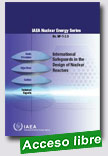 |
International Safeguards in the Design of Nuclear Reactors
IAEA Nuclear Energy Series, 2014, 50 p.
This publication is part of a series being prepared to help inform designers, governments and the public about nuclear material safeguards. It provides information regarding the implementation of international safeguards that States, operators or other entities may take into consideration when planning new nuclear facilities. Proper implementation during construction will facilitate the safeguards activities required during the subsequent facility operation and |
decommissioning. this publication includes experience gained in past efforts to incorporate safeguards requirements in the facility design which can be useful in future efforts to build or operate nuclear facilities.
Extraído de: http://www-pub.iaea.org/MTCD/Publications/PDF/Pub1669_web.pdf
|
| |
|
|
|
|
| |
| |
|
|
| |
| |
|
|
| |
|
|
|
| |
|
|
|
| |
|
